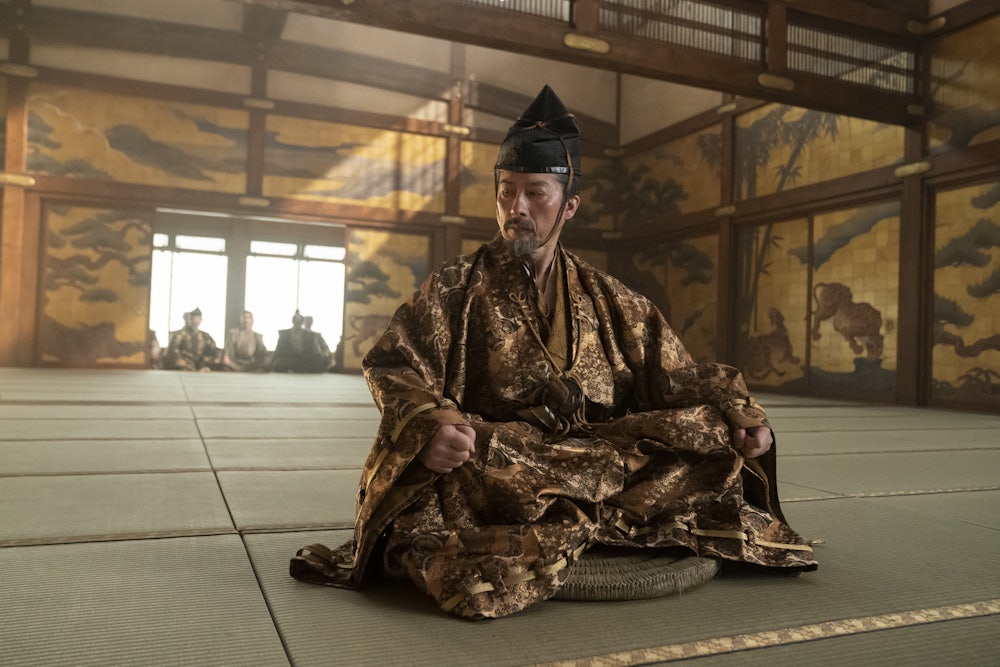Last fall, I made a classroom full of 20-year-olds read The Da Vinci Code. It was a seminar for junior American culture studies majors, and one of the themes was to focus on cultural texts from the year 2003, the year when most of them were born. We read The Da Vinci Code because it was the bestselling book of that year, it provoked months of controversy and obsession, and it was spun off into a series of blockbuster movies. It was a big deal! As the novel was quite literally “before their time,” I doubted they would have read it already, but I assumed there’d be some degree of familiarity. (One assignment was that they had to take the book home over Thanksgiving break, read it conspicuously in front of any millennial or Gen X people in their lives, and report back.) Turns out, barely any of the students in my class had even heard of it.
People, in other words, forget things fast. For that reason, I don’t suspect any of my students have heard of James Clavell’s 1975 historical novel Shōgun either. Shōgun, which has just been adapted as an epic limited series by FX, was also a massive bestseller, which ignited a tremendous popular interest in its subject, and was adapted into an extremely successful miniseries. Depending on your age, perhaps you read Shōgun in the 1970s, perhaps you saw your parents read it or watched the Richard Chamberlain/Toshiro Mifune miniseries in the 1980s, or, perhaps, like me, you grew up in a world where every home bookshelf you saw came with an obligatory, bricklike copy of Clavell’s 1,200-page novel as its cornerstone. I never read Shōgun, but it was a recognizable, ubiquitous cultural object throughout most of my adolescence.
This is all to say that, even for people who read the novel at the height of its popularity nearly 50 years ago or simply remember that half-unsheathed katana hilt book cover as an iconic image of their youths, the new miniseries adaptation bears very little burden of expectation from its viewers in 2024. Clavell’s novel, while popular, is not compulsory reading anymore, and while the miniseries was critically lauded in its time, it isn’t available to stream on any platform. (An article from this year suggests the easiest way to see the 1980 series is to find a copy at a local library.) This slow fade makes the new Shōgun the rare adaptation that can operate relatively free from demands for fidelity that often trouble a new series.
Developed by FX over a period of 10 years and helmed since 2018 by Rachel Kondo and Justin Marks, this Shōgun can and does stand fully on its own. It won’t rival the novel for its popularity, and it’s simply impossible for any TV show in our current subscription-based, streaming moment to access the kind of audience the 1980 miniseries did, but Shōgun is a colossal achievement all the same. It provides the kind of transporting saga that TV executives have been desperately thirsting after for the past decade, but its style is a slow burn rather than a series of sensational pyrotechnics. If the Peak TV limited series relied on stars and spectacle and easy familiarity, Shōgun asks us to become a different type of spectator, more patient, less distractable. In this way, it is a defining event of the post–Peak TV era.
Shōgun begins in the lurching and keeling bowels of a rotting pirate ship, and it begins in English. It’s a bit of a feint, as the pirate Blackthorne (Cosmo Jarvis) is soon captured by a unit of Japanese soldiers, and most of the rest of this audaciously expansive epic will take place within the meticulously clean, angular, minimalist interiors and courtyards of feudal Japan. It will also proceed, largely, in Japanese with English subtitles. Blackthorne, who is soon renamed Anjin, or “Pilot,” by his captors, is this show’s window into the action, but it’s not long before even he realizes that he is not the protagonist of this particular tale. He arrives in Japan ranting about its “savages,” aghast at their apparent cruelty, only to realize his prejudices and petty schemes won’t get him far in this new setting, that there are plot machinations at work that he’s not equipped yet to perceive.
Rather than setting things in motion, then, it soon becomes clear that Blackthorne has arrived in the middle of the show’s main intrigue. The Taikō, or supreme regent of Japan, has just died, but, because his son and heir is too young to assume power, the realm has been left in the hands of a council of five daimyo regents. Four of these regents operate as a bickering alliance, led by Ishido Kazunari (Takehiro Hira) out of Osaka castle, and they’ve aligned largely to ostracize and consolidate power against the fifth regent, Yoshii Toranaga (the magisterial Hiroyuki Sanada), who was the Taikō’s favorite and also the most powerful of the council. When Blackthorne’s ship washes up in the bay, the council is in the process of its attempt to impeach Toranaga, an action that would, ultimately, lead to him and his entire retinue being sentenced to death. Blackthorne’s arrival matters less because of Blackthorne himself than it does because it briefly destabilizes the status quo, creating a small amount of chaos that Toranaga can use to his advantage.
Blackthorne, then, is a pawn, as are most of the other characters we meet, whether they know it or not, and whether they view it as an honor or a curse. His opposite number is Lady Mariko (an incredible Anna Sawai), the daughter of a disgraced lord. Because she’s been tutored (and converted) by the Jesuits, she speaks excellent Portuguese, and Toranaga enlists her to translate for Blackthorne, who has picked up the language on his travels. That Mariko and Blackthorne strike up a forbidden infatuation is easy to guess, though it might be frustrating to some viewers that their romance never ascends to the status of a love story in this series. Both of these characters have roles to play in the interlocking, often obscured schemes Toranaga sets in motion to oppose and defeat his enemies on the council. Their entanglement instead merely further complicates the way they read and are read in the process.
One of the main features of this show—and the source of its most important narrative innovation—is how rigorously rule-bound its characters are. It can make certain actions or choices (even fatal ones) seem cruelly or vexingly unnecessary, but it also forces the viewer to accept a kind of patience that’s unusual in contemporary TV. Many of Toranaga’s initial gambits, for instance, are bureaucratic ones. His enemies are bloodthirsty, but they are limited by the processes of law, so Toranaga jams the works. If the council votes on his impeachment, he’s dead, so Toranaga schemes to prevent the vote. He uses the “heretic” Blackthorne’s mere presence to split the council, two of whom are converted Christians. He resigns in order to force Ishido to figure out a way to replace him before the vote. At one point, seated in front of his enemies on the council, Toranaga seethes, “these meetings are exhausting,” but it is precisely his skillful manipulation of the council’s bureaucracy that saves him. There are traitors and true believers, nested lies and cantilevered deceptions, brutal executions and honor-bound suicides, but these all transpire within an inviolable set of rules, regulations, and intricately observed customs. There is always a process.
Yabushige (Tadanobu Asano), one of Toranaga’s allies who is constantly trying to sell out his lord for his own survival, exists in the show as a kind of aberration. He’s the sort of open schemer, braggart, and sadist who would have done well in a different world, say that of Game of Thrones, but here, he’s too coarse and crudely calculated to be effective. Even at the level of acting style, Asano’s vulgar, charismatic Yabushige puts Sanada’s crafty, composed Toranaga in relief.
It might seem that a show built around a series of complex, mostly hidden Rube Goldberg plot mechanics would be dramatically inert, but the opposite is true. We learn to pay closer and closer attention, never knowing which spectacular act of violence, which heartbreaking betrayal, which fleeting glance might signal that the plan has snapped into place. Shōgun is not just a voluptuously mounted historical epic, it’s a daring experiment in the kind of narrative we can immerse ourselves in.
To say that Shōgun is a defining moment is not to say it’s a wholly representative one. Peak TV got its name from FX executive John Landgraf in 2015, describing an environment in which traditional networks and streamers were engaged in a bloated arms race that was producing far more content—and far more mediocre content—than a single human being could ever watch. A big part of this glut has consisted of poorly conceived and poorly manufactured epics. Premium cable networks and streamers have been trying—and largely failing—to make giant, expensive event series ever since Game of Thrones went nuclear. The problem is that such series are not only hard to pick (why did Outlander work, for instance, but not Foundation or The Wheel of Time?), they’re also incredibly hard to make. Amazon paid nearly a billion dollars to launch The Lord of the Rings: The Rings of Power (including a full quarter-billion for rights), a prequel to one of the most universally beloved film franchises of all time, and less than half of viewers could even bring themselves to finish watching the first season. Big-budget epics have been a constant object of desire for streaming and network executives for the better part of a decade, but their success has been rare and hard to predict. TV, for the past decade, has been in out-of-control copycat mode, and the returns have been diminishing.
Landgraf recently announced that, after a little over eight years, TV production is finally declining. Peak TV, then, has ended, spiritually and statistically. The number of scripted series is down 14 percent since 2022, and streamers have begun to focus on profits rather than subscriber numbers or average revenue per user. That has meant fewer shows in production, fewer bags of money thrown at possible high-risk game changers, fewer bites at the proverbial apple.
Shōgun began its development at the beginning of Peak TV and is finally premiering now at its end. It is the tortoise that has outlasted the hare. Almost by definition, the shows that explode our expectations, that define their times, are the shows that defy the conventions of their moment. Shōgun might not look like a radical break, but it is: Shōgun revels in the high production values, epic scope, and prestige pedigree so valued by the past decade of television, but it also doubles down on its own distinctiveness. This is not an attempt to make a “new” Game of Thrones or a “new” Mad Men or even a “new” Shōgun. It sets its own rules, it plays by them, and it expects its audience to comply.
We are no longer in television’s Gilded Age of excess; Shōgun heralds a new age, which may be defined by this show’s patience and skill or may be crowded with its wan imitators. Kondo, Marks, and even the prophet Landgraf himself have offered up a new vision. Will Shōgun change the landscape or merely serve as a fleeting glimpse of an alternate future? To this question, we may offer only another question, posed by Yabushige: Why tell a dead man the future?




